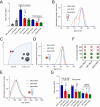Local environment in biomolecular condensates modulates enzymatic activity across length scales
- PMID: 38637545
- PMCID: PMC11026464
- DOI: 10.1038/s41467-024-47435-w
Local environment in biomolecular condensates modulates enzymatic activity across length scales
Abstract
The mechanisms that underlie the regulation of enzymatic reactions by biomolecular condensates and how they scale with compartment size remain poorly understood. Here we use intrinsically disordered domains as building blocks to generate programmable enzymatic condensates of NADH-oxidase (NOX) with different sizes spanning from nanometers to microns. These disordered domains, derived from three distinct RNA-binding proteins, each possessing different net charge, result in the formation of condensates characterized by a comparable high local concentration of the enzyme yet within distinct environments. We show that only condensates with the highest recruitment of substrate and cofactor exhibit an increase in enzymatic activity. Notably, we observe an enhancement in enzymatic rate across a wide range of condensate sizes, from nanometers to microns, indicating that emergent properties of condensates can arise within assemblies as small as nanometers. Furthermore, we show a larger rate enhancement in smaller condensates. Our findings demonstrate the ability of condensates to modulate enzymatic reactions by creating distinct effective solvent environments compared to the surrounding solution, with implications for the design of protein-based heterogeneous biocatalysts.
© 2024. The Author(s).
Conflict of interest statement
The authors declare no competing interests.
Figures




Similar articles
-
Conformational Dynamics of Intrinsically Disordered Proteins Regulate Biomolecular Condensate Chemistry.Chem Rev. 2022 Mar 23;122(6):6719-6748. doi: 10.1021/acs.chemrev.1c00774. Epub 2022 Feb 18. Chem Rev. 2022. PMID: 35179885 Free PMC article. Review.
-
Protein compactness and interaction valency define the architecture of a biomolecular condensate across scales.Elife. 2023 Jul 20;12:e80038. doi: 10.7554/eLife.80038. Elife. 2023. PMID: 37470705 Free PMC article.
-
Toward Design Principles for Biomolecular Condensates for Metabolic Pathways.Adv Biol (Weinh). 2025 May;9(5):e2400672. doi: 10.1002/adbi.202400672. Epub 2025 Apr 7. Adv Biol (Weinh). 2025. PMID: 40195042 Free PMC article. Review.
-
Regulation of enzymatic reactions by chemical composition of peptide biomolecular condensates.Commun Chem. 2024 Apr 20;7(1):90. doi: 10.1038/s42004-024-01174-7. Commun Chem. 2024. PMID: 38643237 Free PMC article.
-
Heterogeneous Slowdown of Dynamics in the Condensate of an Intrinsically Disordered Protein.J Phys Chem Lett. 2024 Nov 14;15(45):11244-11251. doi: 10.1021/acs.jpclett.4c02142. Epub 2024 Nov 1. J Phys Chem Lett. 2024. PMID: 39486437 Free PMC article.
Cited by
-
Atomic resolution map of the solvent interactions driving SOD1 unfolding in CAPRIN1 condensates.Proc Natl Acad Sci U S A. 2024 Aug 27;121(35):e2408554121. doi: 10.1073/pnas.2408554121. Epub 2024 Aug 22. Proc Natl Acad Sci U S A. 2024. PMID: 39172789 Free PMC article.
-
LLPS REDIFINE allows the biophysical characterization of multicomponent condensates without tags or labels.Nat Commun. 2025 May 19;16(1):4628. doi: 10.1038/s41467-025-59759-2. Nat Commun. 2025. PMID: 40389460 Free PMC article.
-
Coacervates as enzymatic microreactors.Chem Soc Rev. 2025 May 6;54(9):4183-4199. doi: 10.1039/d4cs01203h. Chem Soc Rev. 2025. PMID: 40084439 Free PMC article. Review.
-
Enhancement of enzymatic activity by biomolecular condensates through pH buffering.Nat Commun. 2025 Jul 10;16(1):6368. doi: 10.1038/s41467-025-61013-8. Nat Commun. 2025. PMID: 40640131 Free PMC article.
-
Dynamic Cytoplasm: A Physical Regulator of Enzymatic Function.Biochemistry. 2025 Jul 1;64(13):2699-2711. doi: 10.1021/acs.biochem.5c00212. Epub 2025 Jun 15. Biochemistry. 2025. PMID: 40517322 Free PMC article. Review.

